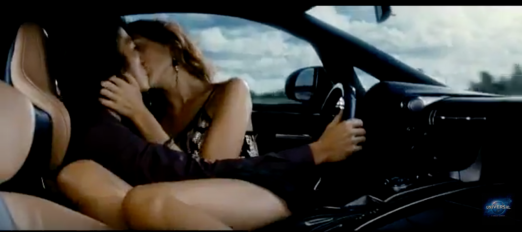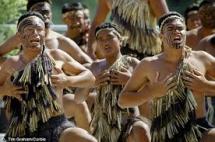HollyWood Cinema
![]() 17th November 2017 – Rohit Assi
17th November 2017 – Rohit Assi
French filmmaker and critic Jean-Luc Godard once said
From this alone we seem to set up even the simplest conventions for main-stream cinema. For example if we took one of the most popular film franchises say… “The Fast and Furious”, A franchise that is dearly loved by an Hollywood audience, it is
 evident that Jean-Luc’s statement still has relevance. For example within the mise-en-scene of the trailer there is a strong presence of both ideologies. Plenty of pretty women to accompany the strong masculine males and guns to ensure an entertainment factor for the audience.
evident that Jean-Luc’s statement still has relevance. For example within the mise-en-scene of the trailer there is a strong presence of both ideologies. Plenty of pretty women to accompany the strong masculine males and guns to ensure an entertainment factor for the audience.

So where did these conventions start and are they still prominent factors for all cinema?
Hollywood history begins in the year 1912 with a man called Adolph Zukor whom founded one of the most prominent Hollywood studios “Paramount Pictures”. Then followed the founding of three other major studios. Soon all four studio’s will go onto be known as “THE BIG FOUR” (Paramount Pictures, MGM, Fox Studios and Warner Bros). Each studio would go on to pioneer the industry from New York. However it wasn’t until the move to Los Angeles that the studios would have a big impact. Many Directors initially loved California . One for the location itself and the other for its environment. Even with its luxurious landscape the audience had different intentions. The sex and violence themes tended to fascinate the Californian audience the most. However this alone reflected the state itself as there were ongoing national issues such as earthquakes, floods and ghettos within the state.
1930s is seen as the one true year for the beginning of Hollywood’s golden age, thus meaning that Hollywood became the most prominent business in the entire country. Arguably two of the biggest films to come out of the 1930s itself was ” Gone with the wind”. Looking at the Mise-en-scene of the narrative, the film does arrive to the very notion of Jean – Luc’s. For example the main theme of the film is war and peace. The “Gun” part of Jeans notion would reflect to America’s civil war in contrast the “girl” references the love interest with the main protagonist thus referring to the “peace” notion.
Following through we know enter the 1940s. The most prominent auteur we find here is Alfred Hitcock although his mainstream success really began in the 50’s . Hitchcock’s films continued this notorious trend as majority of his films involved sexuality and violence. For example in “North by northwest” the narrative is a love story between a man and a women.
Hitchcock films have always used plenty of murder weapons. However not all have been “guns”, just knifes. None the less Hitchcock has used this violence as a subject within plenty of his films ranging from “blackmail”, “psycho”, “sabotage”.
From looking at Hollywood films from the 30s to 50s, it does seem they tend to encompass their narratives around the two ideals of Jean Luc! However is this the same for international cinema.
Brazilian Cinema
Unlike Hollywood the Brazilian cinematic industry had a late start and once Brazil got the their hands on the first “cinematograph” It wasn’t even meant for making features! Brazil’s first form of moving pictures where more documentary’s, used for filming local events . Brazil’s earliest of films also tended to be themed around football. “Humberto Mauro” was the earliest influential film director to date. Mauro made pictures that cinematically reflected everyday life in Brazil especially in the Favla.
. Brazil’s earliest of films also tended to be themed around football. “Humberto Mauro” was the earliest influential film director to date. Mauro made pictures that cinematically reflected everyday life in Brazil especially in the Favla.
This leads us arriving to Brazilians golden age, a movement called the cinema “Novo” that began in the 1960 and 1970s just after Hollywood took over. “Novo” translated to English means home, and the genre itself was to emphasise the inequality of Brazil as A whole. “italian realism” and the “French new wave” inspired the movement. This inspired “Novo” because both movements made films based on social issues. In other words kind of like Hollywood but much “less glossy” and “more harsh” as filmmaker “Glauber Rocha” once said. Films of the movement had a more natural tone. Unlike Hollywood’s materialistic look each film had used the natural settings along with using starvation and poverty as the theme. Within the Mise-en-scene of “Bye bye brazil”, “Macunaima” and “Dragão da maldade” although there is tremendous sense of “woman” or “girl” in each of these films. As Jean Luc states the “Gun” ideology out of the two is the most prominent from most of brazils symbolism. For example within “Macunaima” and “Dragão da maldade” they have a huge deal with violence and gang mentality that surrounds the narrative. One of the most mainstream examples of Brazilian warfare is from 2002’s “City of God” and 2007s “City of Men”.
Even dating back to Brazil’s “Novo” moment in the 60’s, weapons and violence where defiantly a staple for Brazil’s real lifestyle and if the movement was to base motion-picture on “realism” gun grime was a staple of Brazilian society. “Dragão da maldade” and “City  of God” defiantly share a sentiment when it comes to a mentality of crime. The use of the “Gun” is a notion seen by many as a use of “Control” and “Power” in Brazilian Society. “Lil Ze” one of the main antagonists of the film used his gun mainly for power and control as he soon became a gang leader. In contrast however “Dragão da maldade” , “Antonio das Mortes” the protagonist uses a gun to defeat the films antagonist in-order to save the town, this had a “slay the dragon” type iconography.
of God” defiantly share a sentiment when it comes to a mentality of crime. The use of the “Gun” is a notion seen by many as a use of “Control” and “Power” in Brazilian Society. “Lil Ze” one of the main antagonists of the film used his gun mainly for power and control as he soon became a gang leader. In contrast however “Dragão da maldade” , “Antonio das Mortes” the protagonist uses a gun to defeat the films antagonist in-order to save the town, this had a “slay the dragon” type iconography.
Overall looking at Brazilian cinema there is a strong argument that a “gun” or any pistol like weapon has a deep representation within the iconography of an Brazilian film. therefore differing from Hollywoods output.
South Korean Cinema
Korea when it comes to initial thought, cinema isn’t generally a primary consideration. In fact most of us even tend to think about it’s political stance. We’re even most likely to think about the north rather than the south. However South Korean tends to have an significant film industry. For example on IMBD “Top 250 Films” list plenty of Korean entries appear. So is Korean cinema anything like a “Blockbuster”.
Korea’s Cinema Similar to Hollywood had its first golden age around the same time, in the 50s however its own start was government dependent. Similarly to Hollywood, South Korea cinema had a blue print to follow. For example you needed
- A studio
- Three 35 mm cameras
- Lighting
- Full time contracted directors and actors
This leads to Korean audiences to feel cynical about America cinema even to point where in the early 1980s audiences in “Seoul” attacked local theatres, this even included working directors and actors. Theatre chains showing any Hollywood feature such as “Indiana Jones” where attacked due the audiences feeling deprived of Hollywood taking the attention away from the industry. Even today national Korean cinema has been batteling for the main stage.
Korean cinema has always seemed to distance itself from the typical Hollywood tropes. Director “Kwon Taek” an early pioneer for Korean cinema  like many other film-makers often distanced himslef from genres. Director/writer Kim Jee-Woon
like many other film-makers often distanced himslef from genres. Director/writer Kim Jee-Woon
 looked at the Hollywood genre trope as a model to be “manipulated”, to found un-discovered cinematic energy. This always gave Korean cinema even most successful film an art house feel. For example old boy or 1999s “Shiri”.
looked at the Hollywood genre trope as a model to be “manipulated”, to found un-discovered cinematic energy. This always gave Korean cinema even most successful film an art house feel. For example old boy or 1999s “Shiri”.
“Shiri” was South Koreas first blockbuster in its history, to the point where it was even promoted by “Samsung” entertainment. In the Mise-en-scene of “Shiri”, a lot of similarities can be compared even to the most main streams of Hollywood films. For example “Shiri” has special effects and even choreographed actions. 1999 was a year known for its action spectacles as films such as “Fight Club”, “Star wars” and even the “Matrix” came out in the same year .For this film alone Director “Kang Je-Gyu” was even compared to Spielberg. The only thing “Shiri” had that compared it to all three was its political theme. The narrative surrounds the conflict between the North and the South.
Korean Cinema in looking on the surface conventionally looks like Hollywood, however looking further Korean cinema style is vastly different to Hollywoods. One example is that Korean films have a vastly quality of colour saturation.

 Korean films have always been visually sophisticated. This is a notion that derives from Korea’s paintings where either the subject or the environment where over saturated
Korean films have always been visually sophisticated. This is a notion that derives from Korea’s paintings where either the subject or the environment where over saturated
with colour to brings out its significance.
Overall to argue with Jena-Luc’s statement, Korean cinema has plenty of similarities with Hollywood. Korean cinema can even been seen as a example of main stream in the East. It is evident that Korea has been influenced by Hollywood from the beginning however similar to brazil Korea tends to bend the models America shaped. For example the melodrama has been used a numbers times. This is especially found in “Kim Jee-Woons”, “The quiet Family”. Even “women” who are a staple of Hollywood conventions are represented differently in Korean motion-picture.
New Zealand Cinema
Like Brazil, New Zealand had no moving-picture industry. Similarly to Brazil early cinema came in the form of filmed live events, especially the visit from the Duke and Duchess in the early 1900s. It was here that James McDonald, governmental filmmaker recognised the potential of NZ, especially with its scenic attraction.
The NFU(National film unit) got established in 1941 unit. who produced many shorts based on the scenic factor alone.


However each short was made with little to none technical ability and financial backing.
New Zealand cinematic wave began around the 1970s. Roger Donaldson writer/director became a leading man in the development of early New Zealand cinema. Roger began his career with “sleeping dogs”. The 70s where a great period for NZ cinema as the industry had produced the most than any year prior.
New Zealand as whole is known for a lot of things, mountains, fields, “Lord of the Rings”, their accent, Sam Niel, However you can’t deny New Zealand’s Maori culture. The Maori culture can be seen in-beded in NZ’s DNA. The Maori people are original settlers of the island. The Maori traditions and stories formed the basis of New  Zealand’s earliest features. For example within the Mise-en-scene of Roger Donaldson’s “Sleeping dogs” the man protagonist escapes to a more rural area that coincidentally is owned by a Maori tribe. Even though the narrative has an escapist theme and isn’t centralised on the tribes men themselves it still has a presence. It was here in the 70s that that the Maori people finally had an on-screen presence, with the following decades of the 80s and 90s. Films in the early 70s such as “To love A Maori’ “Ngati” where the first to do so. One of the main practises of the culture is the ever physical Haka war dance. The “Haka” first appeared in main stream NZ cinema with “Once where warriors”.
Zealand’s earliest features. For example within the Mise-en-scene of Roger Donaldson’s “Sleeping dogs” the man protagonist escapes to a more rural area that coincidentally is owned by a Maori tribe. Even though the narrative has an escapist theme and isn’t centralised on the tribes men themselves it still has a presence. It was here in the 70s that that the Maori people finally had an on-screen presence, with the following decades of the 80s and 90s. Films in the early 70s such as “To love A Maori’ “Ngati” where the first to do so. One of the main practises of the culture is the ever physical Haka war dance. The “Haka” first appeared in main stream NZ cinema with “Once where warriors”.
Another element of kiwi cinema is the use of fantasy and gothic tropes. Fantasy films compared to Hollywoods understanding of “Fantasy” deals with darker imaginary. So in other words its like comparing 1986s “Labyrinth” to “meet the feebles” . Meet the Feebels was so controversial that it caused up raw especially with the The Times who where quoted for saying it was “In bad taste”. “Gothic” NZ cinema on the other hands is surprisingly different. The gothic film genre tended to have a more physiologic notion. For example within the mise-en-scene of the “Scarecrow” the rural environment was a concept of isolation and fearing to never feel true freedom. In comparison to the “Road movie” genre in NZ where location has pastoral values metaphorical meaning refuge from the outside world. The main theme here seen in “Good bye pork pie”.
In conclusion New Zeland cinema compared to other international and of course Hollywood is an entire different direction to cinema itself. While Hollywood works hard to provide audiences with dramatic but typical imagery. Similarly to both South Korea and Brazil NZ focuses on a core aspect of it’s DNA, simply put to quote Chris berry’s notion the “Blockbuster is no longer American owned”.
